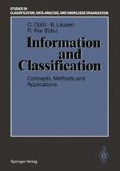Abstract
This paper considers the problem of choosing the number of component clusters of individuals within the context of the standard mixture of multivariate normal distributions. Often the number of mixture clusters K is unknown, but varying and needs to be estimated. A two-stage iterative maximum-likelihood procedure is used as a clustering criterion to estimate the parameters of the mixture-model under several different covariance structures. An approximate component-wise inverse-Fisher information (IFIM) for the mixture-model is obtained. Then the informational complexity (ICOMP) criterion of IFIM of this author (Bozdogan 1988, 1990a, 1990b) is derived and proposed as a new criterion for choosing the number of clusters in the mixture-model. For comparative purposes, Akaike’s (1973) information criterion (AIC), and Rissanen’s (1978) minimum description length (MDL) criterion are also introduced and derived for the mixture-model. Numerical examples are shown on simulated multivariate normal data sets with a known number of mixture clusters to illustrate the significance of ICOMP in choosing the number of clusters and the best fitting model.
Access this chapter
Tax calculation will be finalised at checkout
Purchases are for personal use only
Preview
Unable to display preview. Download preview PDF.
References
Akaike, H. (1973), Information Theory and an Extension of the Maximum Likelihood Principle, in: B. N. Pretrov and F. Csaki (eds.), Second International Symposium on Information Theory, Academiai Kiado Budapest, 267-281.
Binder, D.A. (1978), Bayesian Cluster Analysis, Biometrika, 65, 31–38.
Bock, H. H. (1981), Statistical Testing and Evaluation Methods in Cluster Analysis, in the Proceedings of the Indian Statistical Institute Golden Jubilee International Conference on: Statistics: Applications and New Directions, J. K. Gosh and J. Roy (eds.) December 16–19, Calcutta, 116-146.
Bozdogan, H. (1981), Multi-Sample Cluster Analysis and Approaches to Validity Studies in Clustering Individuals, Ph.D. thesis, Department of Mathematics, University of Illinois at Chicago, Chicago, Illinois 60680.
Bozdogan, H. (1983), Determining the Number of Component Clusters in the Standard Multivariate Normal Mixture Model Using Model-Selection Criteria, Technical Report No. UIC/DQM/A83-1, June 16, 1983, ARO Contract DAAG29-82-k-0155, Quantitative Methods Department, University of Illinois at Chicago, Chicago, Illinois 60680.
Bozdogan, H. (1987), Model Slection and Akaike’s Information Criterion (AIC): The General Theory and Its Analytical Extensions, Psychometrika, Vol. 52, No. 3, 1987, Special Section (invited paper), 345-370.
Bozdogan, H. (1988), ICOMP: A New Model Selection Criterion, in: Hans H. Bock (ed.), Classification and Related Methods of Data Analysis, North-Holland, Amsterdam, April, 599–608.
Bozdogan, H. (1990a), On the Information-Based Measure of Covariance Complexity and its Application to the Evaluation of Multivariate Linear Models, Communications in Statistics, Theory and Methods, 19(1), 221–278.
Bozdogan, H. (1990b), Multisample Cluster Analysis of the Common Principle Component Model in K Groups Using an Entropic Statistical Complexity Criterion, invited paper presented at the International Symposium on Theory and Practice of Classification, December 16–19, Puschino, Soviet Union.
Bozdogan, H. (1992), Mixture-Model Cluster Analysis and Choosing the Number of Clusters Using a New Informational Complexity ICOMP, AIC, and MDL Model-Selection Criteria, invited paper presented at the First US/Japan Conference on the Frontiers of Statistical Modeling: An Informational Approach, May 24–29, The University of Tennessee, Knoxville, TN 37996, USA. To appear in: H. Bozdogan (ed.), Multivariate Statistical Modeling, Vol. II, Kluwer Academic Publishers, Holland, Dordrecht.
Day, N.E. (1969), Estimating the Components of a Mixture of Normal Distributions, Biometrika, 11, 235–254.
Everitt, B.S., and Hand, D.J. (1981), Finite Mixture Distributions, Champman and Hall, New York.
Hartigan, J.A. (1975), Clustering Algorithms, John Wiley & Sons, New York.
Hartigan, J.A. (1977), Distribution Problems in Clustering, in: J. Van Ryzin (ed.), Classification and Clustering, Academic Press, New York, 45–71.
John, S. (1970), On Identifying the Population of Origin of Each Observation in a Mixture of Observation from Two Normal Populations, Technometrics, 12, 553–563
Kullback, S., and Leibler, R.A. (1951), On Information and Sufficiency, Ann. Math. Statist., 22, 79–86.
Magnus, J.R. (1989), Linear Structures, Oxford University Press, New York.
Magnus, J.R. (1989), Personal correspondence.
Magnus, J.R., and Neudecker, H. (1988), Matrix Differential Calculus with Applications in Statistics and Economitrics, John Wiley & Sons, New York.
Maklad, M.S., and Nichols, T. (1980), A New Approach to Model Structure Discrimination, IEEE Trans, on Systems, Man, and Cybernetics, SMC-10, No. 2, 78–84.
Mclachlan, G.L., and Basford, K.E. (1988), Mixture Models: Inference and Applications to Clustering, Marcel Dekker, Inc., New York.
Rissanen, J. (1976), Minmax Entropy Estimation of Models for Vector Processes, in: R.K. Mehra and D.G. Lainiotis (eds.), System Identification, Academic Press, New York, 97–119.
Rissanen, J. (1978), Modeling by Shortest Data Description, Automatica, Vol. 14, 465–471.
Rissanen, J. (1989), Stochastic Complexity in Statistical Inquiry, World Scientific Publishing Company, Teaneck, New Jersey.
Sclove, S.L. (1977), Population Mixture Models and Clustering Algorithms, Communications in Statistics, Theory and Methods, A6, 417–434.
Sclove, S.L. (1982), Application of the Conditional Population Mixture Model to Image Segmentation, Technical Report A82-1, 1982, ARO Contract DAAG29-82-K-0155, University of Illinois at Chicago, Chicago, Illinois 60680.
Scott, S.L., and Symons, M.J. (1971), Clustering Methods Based on Likelihood Ratio Criteria, Biometrics, 27, 389–397.
Symons, M. J. (1981), Clustering Criteria and Multivariate Normal Mixtures, Biometrics, 37, 35–43.
Titterington, D.M., Smith, A.M.F., and Markov, U.E. (1985), Statistical Analysis of Finite Mixture Distributions, John Wiley & Sons, New York.
Van Emden, M.H. (1971), An Anlysis of Complexity, Mathematical Center Tracts, 35, Amsterdam.
Wolfe, J.H. (1967), Normix: Computational Methods for Estimating the Parameters of Multivariate Normal Mixtures of Distributions, Research Memorandum, SRM 68-2, U.S. Naval Personnel Research Activity, San Diego, California.
Wolfe, J.H. (1970), Pattern Clustering by Multivariate Mixture Analysis, Multivariate Behavioral Res., 5, 329–350.
Author information
Authors and Affiliations
Editor information
Editors and Affiliations
Rights and permissions
Copyright information
© 1993 Springer-Verlag Berlin · Heidelberg
About this paper
Cite this paper
Bozdogan, H. (1993). Choosing the Number of Component Clusters in the Mixture-Model Using a New Informational Complexity Criterion of the Inverse-Fisher Information Matrix. In: Opitz, O., Lausen, B., Klar, R. (eds) Information and Classification. Studies in Classification, Data Analysis and Knowledge Organization. Springer, Berlin, Heidelberg. https://doi.org/10.1007/978-3-642-50974-2_5
Download citation
DOI: https://doi.org/10.1007/978-3-642-50974-2_5
Publisher Name: Springer, Berlin, Heidelberg
Print ISBN: 978-3-540-56736-3
Online ISBN: 978-3-642-50974-2
eBook Packages: Springer Book Archive

